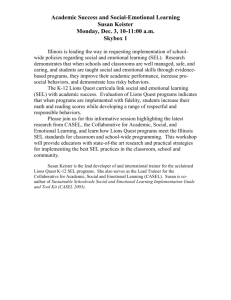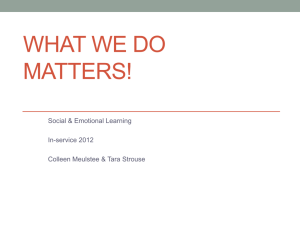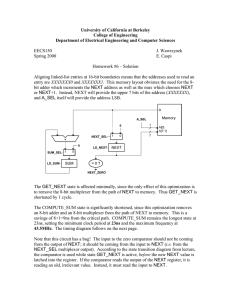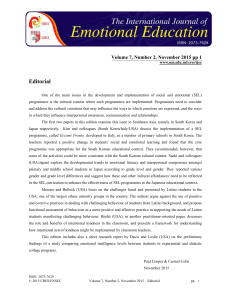2014PersonalSocial
advertisement
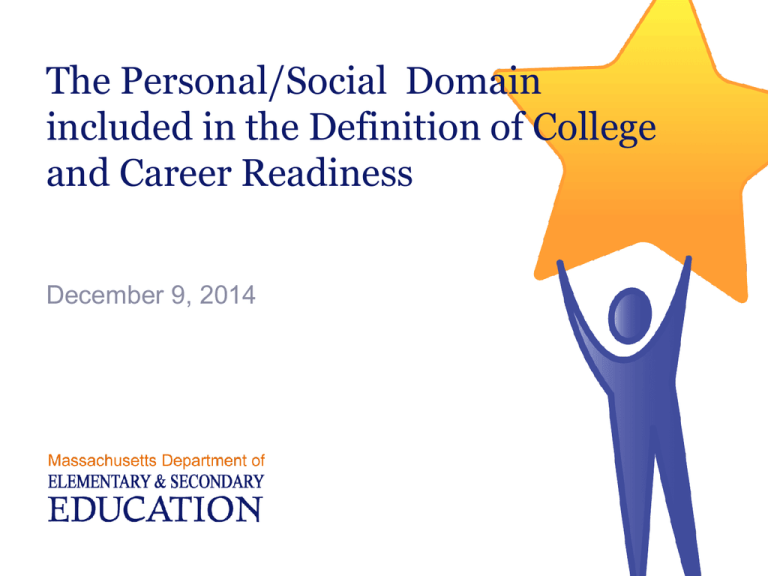
The Personal/Social Domain included in the Definition of College and Career Readiness December 9, 2014 Personal/Social Domain 2 College and career readiness means an individual has the requisite knowledge, skills and experiences in the academic, workplace readiness, and personal/social domains to successfully navigate to completion an economically viable career pathway in a 21st century economy. 3 Social Emotional Learning The Personal/Social domain now recognized to be a critical area for student skill building Still a relatively new area of emphasis for school districts, especially at the high school level Over recent years, a shared language/conceptual framework have emerged for addressing this domain in schools ESE currently using as a framework for this domain the growing body of work related to “Social Emotional Learning” or SEL In this webinar, we will discuss SEL as a guiding strategy for supporting skill growth in the personal/social domain 4 What is Social Emotional Learning? SEL involves the processes through which students and adults acquire and effectively apply the knowledge, attitudes, and skills necessary to understand and manage emotions, set and achieve positive goals, feel and show empathy for others, establish and maintain positive relationships, and make responsible decisions. (Durlak, Weissberg, Dymnicki, Taylor, & Schellinger, 2011). 5 SEL – A National Conversation National experts have developed a substantial body of information and evidence about SEL One leading, widely-cited organization that has guided this work is the Collaborative for Academic, Social, and Emotional Learning (CASEL) http://www.casel.org/about/ Massachusetts has adopted the framework espoused by CASEL for SEL that identifies five key social/emotional skills students need for positive development and effective interaction with others. 6 SEL Core Competencies Self-awareness: Recognizing one’s emotions and values as well as one’s strengths and limitations Self-management: Managing emotions and behaviors to achieve one’s goals Social awareness: Showing understanding and empathy for others Relationship skills: Forming positive relationships, working in teams, and dealing directly with conflict Responsible decision-making: Making ethical, constructive choices about personal and social behavior Source: Collaborative for Academic, Social, and Emotional Learning (CASEL) http://www.casel.org/about/ 7 Several National Trends re SEL Around the country, there is a lack of uniformity about SEL implementation, and it is “housed” in a variety of realms and structures: Health Curricula Guidance structures Academic classroom instruction SEL has been most extensively adopted in early childhood and elementary classrooms Several states have established state-wide standards for SEL, e.g. Illinois and Pennsylvania Massachusetts is currently exploring the creation of a set of standards for SEL 8 Value of SEL for Student Success Research clearly demonstrates that social and emotional skills can be taught through school-based programs There are numerous nationally-available, evidencebased SEL curricula that provide systematic classroom instruction that: Enhance students’ abilities to recognize and manage their emotions Appreciate the perspective of others Establish pro-social goals and solve problems Use a variety of interpersonal skills to handle the challenges of growing up in society 9 Value of SEL for Student CCR Experts are demonstrating the relationship between SEL and students’ college and career readiness The American Institute for Research issued a report in March, 2013, titled “Improving College and Career Readiness by Incorporating Social and Emotional Learning” (the Report) It indicates that “SEL competencies can help students become better communicators, cooperative members of a team, effective leaders and selfadvocators, resilient individuals, and caring, concerned members of their communities,” citing Johnson, Johnson & Stanned, 200; Schpas, Battistich, & Solomon, 2004, Report at 6. 10 SEL Influences Academic Performance In the same AIR Report, authors noted that “Participation in SEL programs was associated with positive impacts on six major student outcomes, including improved SEL skill, attitudes toward self and others, social behavior, and academic performance as well as reduced conduct problems and emotional distress.” The authors find that SEL’s impact on academic performance translates to meaningful gain in students’ achievement test scores. Report at 6. 11 Value of SEL for School Climate In addition, SEL curricula feature elements designed to foster positive classrooms and school environments, and build rapport between students and adults SEL has been recommended for use in Massachusetts as a proactive method for improving school climate and preventing bullying, see http://www.doe.mass.edu/bullying/ SEL offers tools and strategies for effective learning environments, serving as classroom management tool It has been incorporated into advisory program as well 12 Relevance of SEL to Tiered Systems of Support SEL is a key element of the MA Tiered System of Supports (MTSS), http://www.doe.mass.edu/mtss/blueprint/ It addresses one of the ten Conditions of School Effectiveness identified in the MTSS Blueprint: IX. Students' social, emotional, and health needs: The school creates a safe school environment and makes effective use of a system for addressing the social, emotional, and health needs of its students that reflects the behavioral health and public schools framework. 13 Value for Students with Barriers “There are a great deal of data indicating that large numbers of students are contending with significant social, emotional, and mental health barriers that prevent them from succeeding in both school and life. Sometimes, the inability to surmount these barriers leads students to engage in risk-taking behaviors, and often this can contribute to poor academic performance. Educators can address some of the social, emotional, and mental health barriers by helping students develop better SEL skills and creating a safe, caring, and wellmanaged learning environment that fosters positive decision making and academic success.” “Improving College and Career Readiness by Incorporating Social and Emotional Learning,” by Allison Dymnicki, Ph.D., Megan Sambolt, and Yael Kidron, Ph.D., March 2013, American Institute for Research, p. 4 14 Additional Web Links The ICCR Task Force Report The Common Definition of College and Career Readiness Additional resources for SEL can be found at SEL Guidelines (para. 9) http://www.casel.org/ http://www.doe.mass.edu/bullying/ http://www.doe.mass.edu/mtss/ (Massachusetts Tiered System of Supports) The AIR Report: http://www.ccrscenter.org/productsresources/improving-college-and-career-readinessincorporating-social-and-emotional 15


